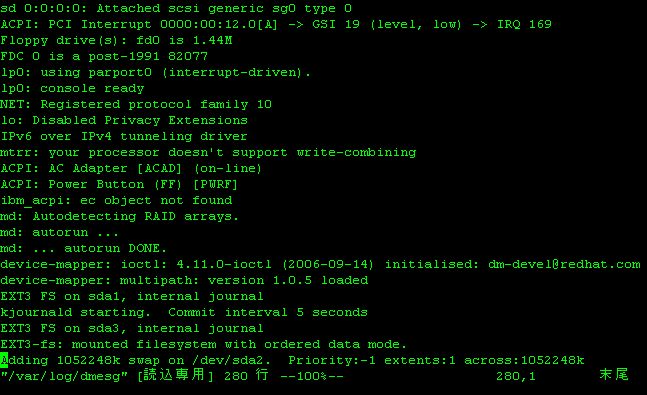5.3 Jump long distance |
The vi command can edit not only a small file but also a big file.
It is difficult to move by a character in a big file. So, you can use commands which move by page, jump to the specific line, and jump to the specific word.
| Command | Action |
|---|---|
| [Ctrl] + f | Move to the next screen |
| [Ctrl] + b | Move to the previous screen |
| :1 | Move to the 1st line |
| :n | Move to the nth line |
| :$ | Move to the last line |
| [Ctrl] + g | Display information about current position |
Table 5-6:Commands for moving by pages and by lines
5.3.1 Page jump
In order to edit large text more quickly, we can use page-jump-commands which let us move to next page or previous page.
Practice: Move page |
Open a existed file "/var/log/dmesg" using vi command.
Because it is a log file, you should quit by force without saving, if you change the file.
$ vi /var/log/dmesg ↵ |
Let's move to the next or previous screen using [Ctrl]+f or [Ctrl]+b.
If you changed the file, quit without saving using ":q!" command.
:q! ?
:q! ↵ |
You can stop inputting command using [Esc] key. If you have mistake to input, input [Esc] key some
times, then quit vi command using ":q!" command.
5.3.2 Jump to the specific line
We also can move to specified line directly.
Practice: Move line |
Open a existed file "/var/log/dmesg" using vi command.
Because it is a log file, you should quit by force without saving, if you change the file
$ vi /var/log/dmesg ↵ |
Let's move to the specific line using ":n" command. You can specify line number after ":" command. If you want to move the 10th line, input ":10".
:10 ↵ |
If you input ":1", you can go back first line.
:1 ↵ |
If you want to move the last line, input ":$".
:$ ↵ |
The command for display information about cursor position is [Ctrl]+g.
Input [Ctrl]+g command, then display the current position.
(Display a contents of /var/log/dmesg)
"/var/log/dmesg" [readonly] line 5 of 531 --0%-- col 8

Figure 5-6: Screen 06-05 Display the number of lines of this moment
If a file is changed, exit without saving using ":q!" command.
:q! ↵ |
